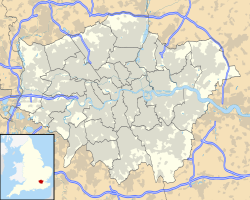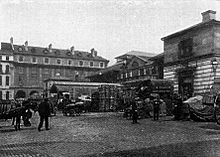Covent Garden
Location of Covent Garden in Greater London |
Covent Garden is a borough of London on the eastern edge of the West End between St. Martin's Lane and Drury Lane . It is known for the Royal Opera House in the north, but is also associated with the former fruit and vegetable market, which has since moved to Nine Elms . Covent Garden is a popular shopping and tourist attraction. Often, Covent Garden is only used to refer to the outdoor area originally built for the market with its market halls (Central Market), which is actually called Covent Garden Piazza .
history
Already from the Roman period a population center as part of the then Londinium proven. The district in London was named Covent Garden during the reign of King John Lackland between 1199 and 1256, at that time a 40 acre (16 hectare ) piece of land in the county of Middlesex , bounded to the west and east by today's streets St. Martin's Lane and Drury Lane, north and south by Floral Street and a line between Chandos Place, along Maiden Lane and Exeter Street to Aldwych .
In this rectangle, the monastery or the convent of Saint Peter in Westminster maintained a garden throughout the Middle Ages to meet its daily needs for food. During the following three centuries has been Convent Garden (Covent Garden) an ever more important source of fruits and vegetables for London. The garden was tended by a series of caretakers on behalf of the Abbot of Westminster. This type of award probably led to property disputes with the crown, which Henry VIII resolved with the stroke of a pen in 1540: during the Reformation he withdrew their property from the monasteries in his favor.
He gave part of the land to John Russell, 1st Earl of Bedford . In fulfillment of his father's last wish, King Edward VI. the remaining part of Covent Gardens in 1547 to his uncle Edward Seymour, 1st Duke of Somerset . He had Somerset House built there south of The Strand from 1549 .
When Seymour was beheaded for treason in 1552, the land returned to royal possession and four months later as a reward to whoever was responsible for the Seymour case. 40 acres, known as le Covent Garden and the long acre , were permanently owned by the Earls of Bedford by royal decree.
Today's Covent Garden has its roots in the early 17th century when the land ( the Convent's Garden ) was redeveloped by Francis Russell, 4th Earl of Bedford . Inigo Jones , the most important English architect of the Renaissance , was to create an elegant residential area on his behalf . Inspired by the great piazzas of Rome , Livorno and other Italian cities, he designed a large public square in the center of Covent Garden.
The area quickly became one of the main market vendors' haunts and after the Great Fire of London in 1666, which destroyed many competing markets in the eastern part of the city, Covent Garden's market became the country's most important. Exotic goods from all over the world were brought up the Thames by boat to the market and sold there.
The author Samuel Pepys noted the first mention of a Punch and Judy performance, a typical British puppet show, in his diary in May 1662. It was not until 1830 that the market halls were built as a reminiscence of the Roman baths found in Bath , in order to enable permanent market operations regardless of the weather.
At the end of the 1960s, traffic jams in the small streets around the market had reached such a level that market operations became increasingly uneconomical - the large quantities of goods required to be delivered were a major reason for the traffic problems. The whole area became part of a complete redevelopment plan and after a public outcry in 1973 dozens of buildings around the piazza were given monument status in order to prevent further changes. In 1974 the market finally moved to a new location, the so-called New Covent Garden Market , just under five kilometers southwest near Nine Elms. The site dwindled until the halls were reopened as a shopping center and tourist attraction in 1980. The London Transport Museum is also located in the piazza .
The market square and the Royal Opera House were remarkably connected in George Bernard Shaw's play Pygmalion (which later also provided the material for the musical My Fair Lady ): When Professor Higgins was waiting there for a horse-drawn cab that brought him from the opera Home, he became aware of Eliza Doolittle, who was loudly offering flowers for sale in the foulest Cockney dialect on the market .



